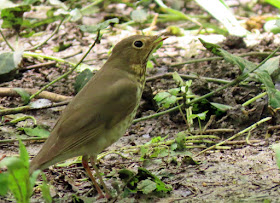 |
| Red-eyed Vireo |
It rained a lot Friday night, but people saw wonderful warblers at Cherokee Park that day, so Saturday morning I resolved to get up and go find them myself. I've now decided that weather forecasts cannot be relied on. If they predict a low chance of rain, you will get wet. If they issue storm warnings, it may not rain at all. Sure, it was raining Saturday as I left the house, but I counted on it being a gentle, light, 35% kind of rain. I was wrong. Although I saw runners, bikers and golfers in the rain, I sat in the deserted parking area for a while before deciding to go on home. Primarily because I didn't want to use my binoculars and camera in the downpour. I was being prudent. By afternoon, the predicted rain had disappeared, and we headed back to the park to look for warblers after finding three amazing warblers in our own back yard. (see previous post)
 |
| Black-throated Blue Warbler |
Beargrass Creek was running high and fast. In fact, it seemed to have overflowed its banks during the night, and everything was really muddy. Good thing I had my mud boots on as we slogged along the banks of the water. One of our target birds, sighted the day before, was the Black-throated Blue Warbler. This is a bird we had seen at Magee Marsh several years ago, so I was familiar with its appearance. The Connecticut Warbler was another target, and I had to ask other birders what it looked like. The described it and said, "It's right in those bushes" but we never did find it.
 |
| Black-throated Blue Warbler |
Anyway, this little guy jumped around under the leaves, hiding from view as much as possible. If the light isn't just right, the blue looks black on him. If he faces you, you don't see the blue back feathers at all.
 |
| Black-throated Blue Warbler |
But, if he turns
just right, you get a marvelous profile view of the black throat and blue back feathers. The definitive field mark is the little white "handkerchief" on his wings. Yes, triumph - we found it on our own! It's great to identify a bird with
confidence while still in the field. I logged the sighting in eBird, and was surprised to see an R for rare sighting next to the name. When I tried to submit my list for the afternoon, eBird demanded that I tell it more about why I thought my sighting was, in fact, this rare bird. When I got home, I was able to submit photos, the best evidence of all! Of course, the same bird was probably reported 20 times that day by various birders.
 |
| Swainson's Thrush |
Some families of birds all look the same without intent study. I've been working on sandpipers this spring, but still get a little confused. Today, there was some kind of thrush every time we turned around. They are all a brown-ish color, with some degree of spots on their breast. But you might have a Wood Thrush, Veery, Hermit Thrush, or Grey-cheeked Thrush, so I kept taking photos of every thrush I could focus on for further research.
 |
| Swainson's Thrush |
Their color can change depending on how much sunlight or shade they are in. If they face away from you, you can't get a good look at the spots on the breast. So when we got home, I made comparisons in
AllAboutBirds.org to go for the details. The best clue I could find was the buffy eyering for the Swainson's Thrush. Every thrush picture had a buffy eyering.
Thrushes sing duets with themselves due to the unique characteristics of their syrinx. The larynx of a human, is higher up the throat, and only one air flow goes through it to make sound. A bird's syrinx, is at the spot where the two bronchial tubes join above the lungs. The bird can control the air flow from each lung to sing an echo or duet with itself, and
thrushes excel at this.
 |
| Acadian Flycatcher |
 |
| Willow Flycatcher ? |
The Nettleroth Bird Sanctuary isn't really a separate park of Cherokee Park, but somehow cool birds tend to find their way in. And the city constructed a boardwalk over the areas that fill with water every time it rains. It really helps, as long as you remember not to step off the boardwalk when trying to see that warbler straight over your head! This is where I missed the Canada Warbler. I saw a large bird with a long tail fly into a tree, then disappear, and thought it might be a cuckoo. Several people reported Yellow-billed Cuckoos, so I may have been right.
 |
| American Restart |
Walking up Maple Road, the two birders in front of us found all sorts of birds. Some have found a family of owls in this part of the park. This American Redstart (a warbler, although you wouldn't think so from his size) finally caught that bug and perched in the open to eat it. Yum! By now, I can hardly walk, my arthritic feet hurt so bad, so we decided to head on home. Where's the ibuprofen?










love the science
ReplyDelete